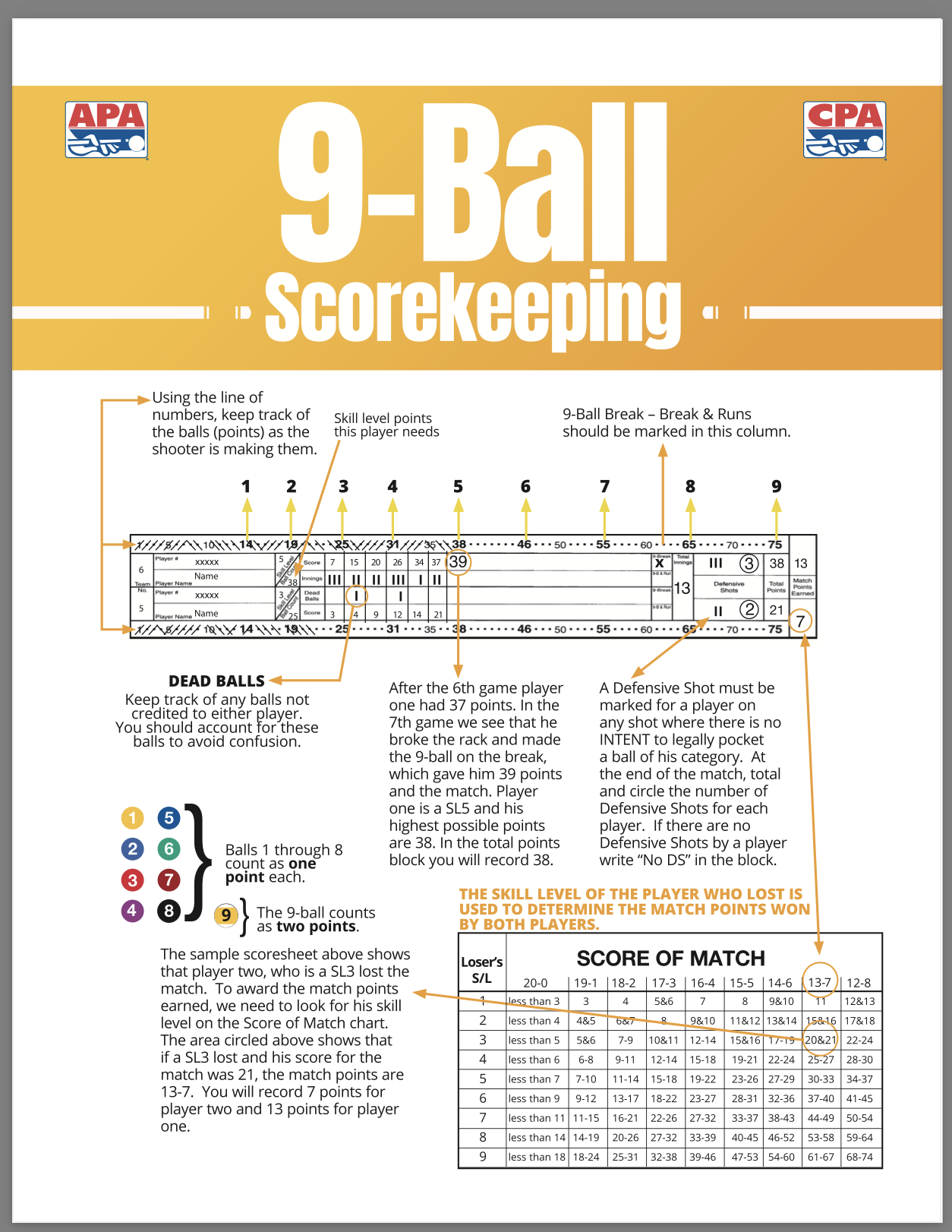How To Use Scoresheets And Score Matches:
How To Score 9-Ball
PAGE 64-65-66
9-Ball scoresheets are two-sided. The scoring is done on the back side, with the rest of the information needed printed on the front side. In order to avoid discrepancies, scorekeepers should confirm the score after each rack. At the end of each rack, the points earned by the two players, plus the number of dead balls, will add up to 10.
A. Player Information
The winner of the lag is listed on top. Refer to the rosters to fill in the player’s team number, player number, last name and first initial, and skill level. Refer to the “Points Required to Win” chart and fill in the number of points the player must earn to win the match. Fill in the same information for the player who lost the lag on the bottom.
B. The Score Section
The score section includes six rows. The top and bottom rows consist of numbers used for tracking points as the shooters pocket balls. The other rows are for recording the players’ information, score, innings and dead balls.
Indicate points earned by diagonally crossing out a number on the top row for the player (singles) or team (doubles) listed on top, or the bottom row for the player (singles) or team (doubles) listed on the bottom. It is recommended you switch from left diagonal lines (\) to right diagonal lines (/) at the conclusion of each rack in order to help track how many points each player earned during each rack. This practice helps you avoid point discrepancies.
NOTE: Balls 1 through 8 are worth one point each. The 9-ball is worth two points.
Score: There are two score lines provided, one for each player (singles) or team (doubles). Record the number of points earned by the player (singles) or team (doubles) at the end of each rack.
Innings: Make a tally mark to indicate each completed inning. An inning is a completed cycle in which both players (singles) or teams (doubles) have had a turn at the table. Separate the number of innings played during each rack by drawing a vertical line to the right of the tally marks at the end of each rack. An inning is not complete, and therefore not marked, until the player (singles) or team (doubles) who lost the lag, and is listed on the bottom, misses or fouls. If a player makes a 9-on-the-Snap or Breaks- and-Runs, mark 9OS or BR instead of zero.
NOTE: Mark Complete Innings Only. If a player (singles) or team (doubles) Breaks-and- Runs a rack, whether another game is needed to determine the outcome or not, the inning has not ended because the player’s turn has not ended. An inning is never marked until the player (singles) or team (doubles) who lost the lag and is the bottom half of the inning throughout the entire match, misses or fouls.
Dead Balls: Record any balls not credited to either player (singles) or team (doubles), such as ball(s) made during a scratch, ball(s) made during a foul, or on the table when the 9-ball is made or a stalemate occurs. The 9-ball is never a dead ball. It is spotted.
C. The 9-Snap and 9-B & Run Blocks
Mark a tally in the appropriate block to record 9-on-the-Snaps and Break-and-Runs for each player.
D. The Total Innings Block
Total all the innings for the entire match and enter the number in
this block.
E. The Defensive Shots Block
Mark a tally for each shot where there is no INTENT by the shooter to legally pocket a ball. Total and circle the number of Defensive Shots for each player at the end of the match. If there are no Defensive Shots played in a match, mark “No DS” in the block. Proper scorekeeping requires conscientious marking of intentionally missed shots and helps to ensure the accuracy of skill levels. The marking of a Defensive Shot does not affect the marking of an inning.
F. The Total Points Block
Enter the total number of points scored by each player (singles) or team (doubles). If a player (singles) or team (doubles) earns more points than the number required for them to win the individual match, do not mark the excess points.
G. Match Points Earned Block
The number of Match Points Earned is determined by the number
of balls made by the losing player (singles) or team (doubles). Fill in
the block using the Score of Match chart located on the front of
the scoresheet.
Singles Format: A total of 20 points are available in each match.
Doubles Format: A total of 40 points are available in each match.
H. Running Total Block
Utilize the Running Total block to add up the Match Points Earned for each of the individual matches played.
I. Team Captains’ Signature Section
A space is provided along the bottom of the scoresheet for the Team Captain’s signature, team name, team number and total Match Points Earned for each team.
